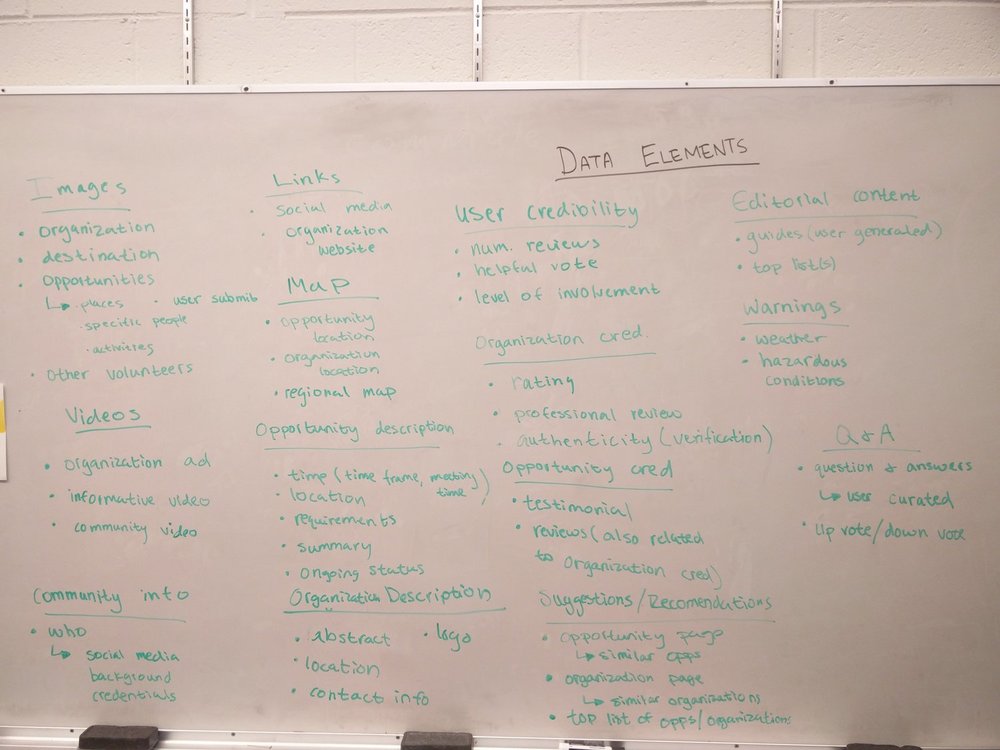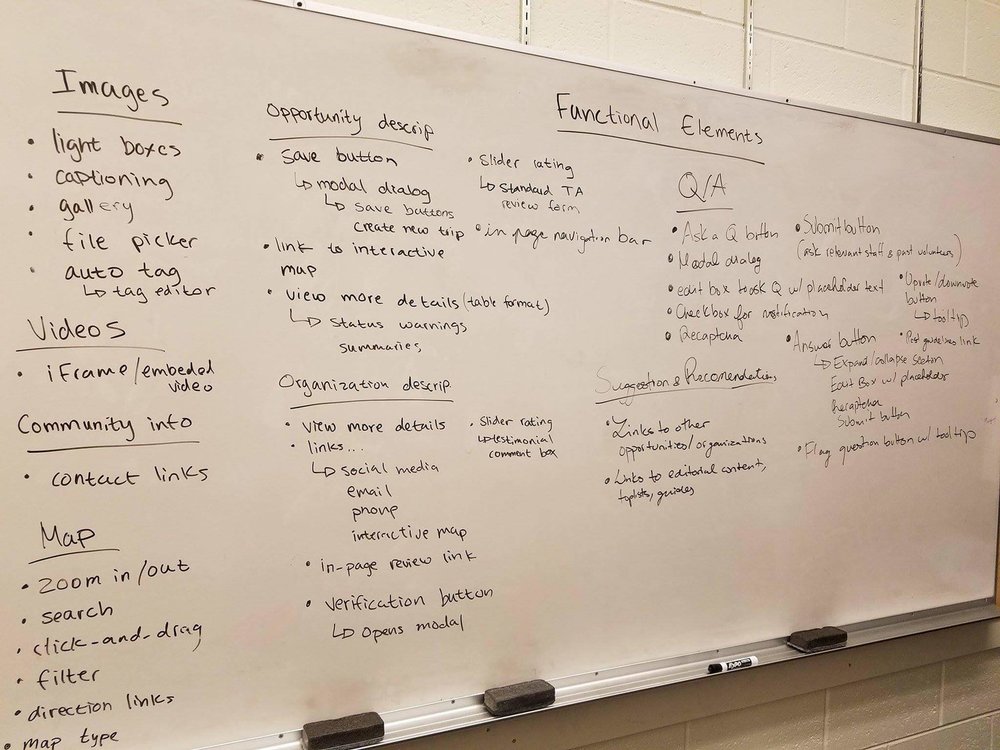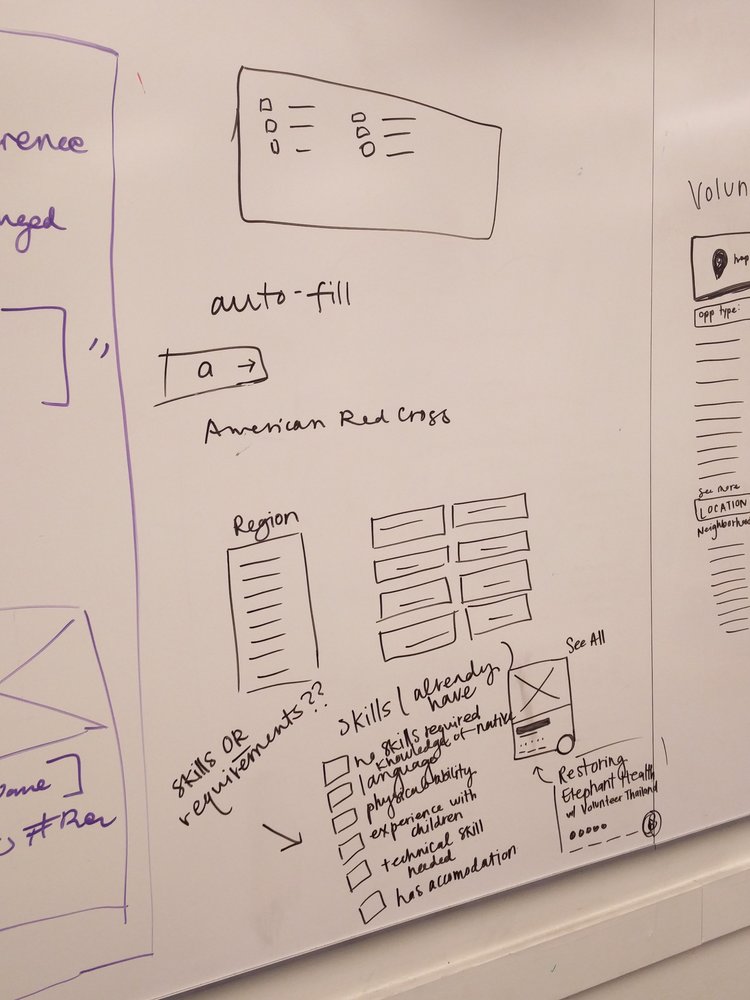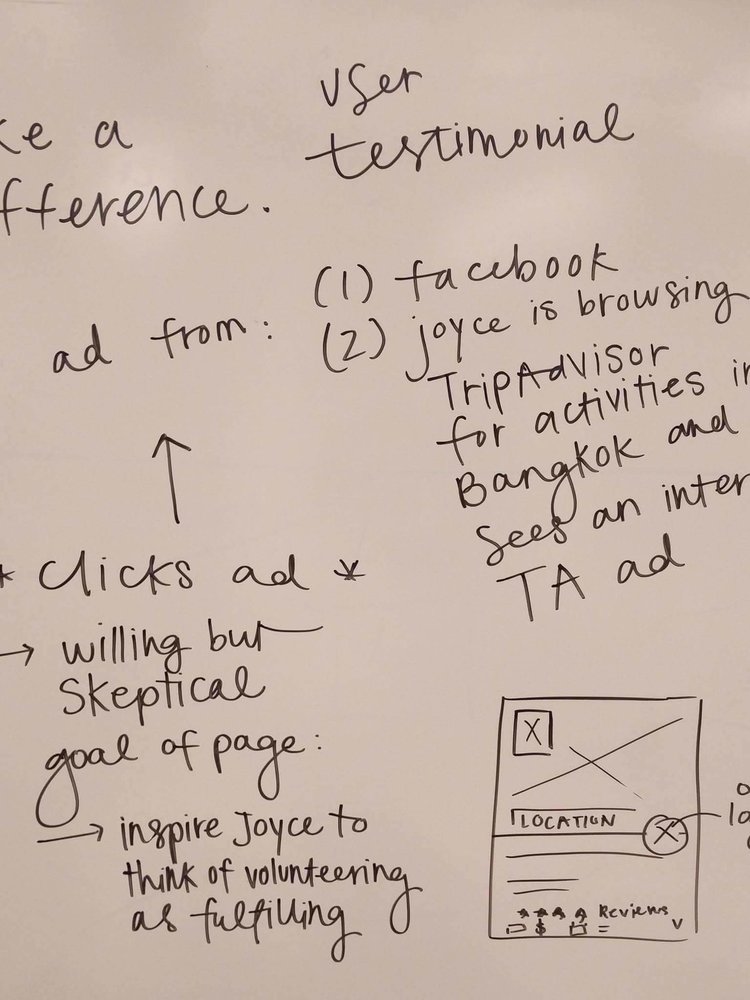beyond tourism
This project took place over 7 weeks, starting in January and ending in February. It's intent was to practice the design process and receive feedback from professionals in the field. Our specific project was to design a tool to connect travelers and volunteers, in partnership with a preexisting website, like REI Adventures.
Project Specifications
research
The team's research was conducted in two parts: Qualitative in person interviews, and an internet survey with free response and yes or no questions. Our interviews and surveys were based off of one central question: what are traveler's attitudes and opinions towards volunteering? We conducted a total of six in person interviews, a handful of responses to our survey. To analyze this data, we utilized affinity diagramming to group and draw conclusions from the data. We came away from this process with three main observations:
1. People are motivated to volunteer while traveling
2. Potential volunteers are looking for fulfilling opportunities
3. Travel is a delicate process that is easily derailed
Affinity Diagramming in process
Affinity Diagram
Competitive analysis
The project specifications required that the team choose a specific company to center the project around. In our competitive analysis, the team analyzed companies over seven main categories: Primary Categories of Travel, Social Networks, Content Type, Personalization, Heuristics, Competitive Advantage, and Community Features. Our initial analysis narrowed the companies down to REI Adventures, Lonely Planet, and TripAdvisor. These companies were finalists since they each carried a distinct personality that the team felt would inspire users. In the end, TripAdvisor was chosen since it also offered a variety and a strong community. Our full analysis can be found here.
problem statement
People are hesitant to volunteer while traveling. They want a fulfilling and worthwhile experience, but time and financial constraints keep them from choosing to volunteer.
Our problem statement was based on the project specification and observation: A lack of volunteering opportunities on travel sites. While many sites offer users different ways to choose a variety of activities and destinations, they often do not have a way for travelers to volunteer during their vacations. This question, coupled with our user research, led to our vision statement:
VISION STATEMENT
The design of our product will help travelers find volunteering opportunities they deem worthwhile and fulfilling by allowing them to filter and find opportunities that are relevant, inspiring and accommodating.
design principles
Synthesizing our research and statements, our team created three main design principles that dictated layout, content, and style decisions.
Credibility
The app should allow the user to feel a sense of security by providing trustworthy information
Inspiration
The app should motivate the user to go outside of their comfort zone and pursue new opportunities
Robustness
The app should be flexible enough to provide opportunities which fit within the constraints of the user
personas
Using the results of affinity diagramming, the team constructed two personas. Will Mook, a manager at Microsoft, is looking to schedule both a trip and a volunteering opportunity. Joyce Murphy, in contrast, is a student looking to fit in a volunteering activity while on her family vacation. The team focused on developing personas that had different goals and aspirations for their volunteering experiences. While Will is build relationships and experience a new place, Joyce is looking for experience to add to her resume. Full personas can be downloaded here.
Joyce Murphy, Primary Persona
Will Mook, Secondary Persona
Context scenarios
Joyce
Joyce just completed her third practice exam for her last final of the academic year. She is worn out. Regardless, she is still stressed out about finding an internship before she graduates. She is daydreaming about her trip to Bangkok that with her parents and boyfriend in three weeks. She is excited but she went there two years ago with her friends and she has visited the key sites already and she wants to find something to do in this next trip.
She, then, goes onto Facebook to just chill and take her mind off of the exam. She notices a sponsored post on her news feed which says “Find Volunteer Opportunities in Bangkok”. Joyce is a little curious that this ad would show up exactly when she wants to travel. In fact, a little creeped out but clicks on it anyway. Once she gets to page, the tool inspires her. She realizes that she can make incredible memories while building her skillset. Joyce scrolls through the featured lists of programs and gets a good sense about what each organization stands for and does. Soon, she lands on a program that speaks to who she is and what she really cares about. Browsing through the program’s opportunities, Joyce is getting more hopeful and excited about the direction of her life and career. Reading through the different opportunities offered by the program, Joyce chooses one that fits her itinerary
Will
Will has just gotten out of a long term relationship and is looking to find a new experience to take his mind off of work and recent events. He has plenty of vacation days, so he decides to travel, but he does not have a destination in mind, so he decides to browse TripAdvisior. While scrolling through destinations on TripAdvisor, he sees a ‘Volunteering’ category. Intrigued, he clicks on it. He browses the list of international programs, and bookmarks a few options. He quickly compares the destination details, and their opportunities, and obtains a firm understanding of each destination’s pros and cons. After he comparing each option, he decides to travel to Haiti and volunteer with the Red Cross.
Persona Expectations
Will
Expects a quick and intuitive searching experience
Expects to feel a sense of security while browsing volunteering opportunities
Expects to find a good variety of volunteering options
Expects to be able to filter out experiences similar to prior examples
Expects to not be coddled by the product
Expects to be able to move freely through the product
Expects to see his volunteering preferences saved
Expects to be well informed about the opportunities he finds
Joyce
Expects to be able to find opportunities that align with her existing travel plans
Wants the product to suggest the most fulfilling opportunities
She wants to feel confident in her pick
Expects to be able to sort opportunities
Expects to be able to well informed about opportunities she finds
IDENTIFYING DESIGN REQUIREMENTS
Based on our our research, the team brainstormed key functional and data elements to be included in the design. Elements were grouped into categories based on how they would fit into the design framework. Below are images of both the functional and data element organization.
Data element sorting
Functional Element sorting
Design sketches
Our initial sketches focused on the placement of each of the functional and data elements on each page. The process took several iterations, and likely would have taken more if our team had a longer timeline. Our team also frequently referred back to Will and Joyce's expectations and scenarios of the website to ensure that key pain points and needs were met. Below are some of our iterations of our sketching process
information architecture
Next our team laid out the information architecture of the volunteer section of the site to visualize the layout of our volunteer section. This allowed our team to tackle each level of design in the architecture in a clear step by step manner.
wireframes
Next our group created wireframes of our design solutions from our information architecture. We focused on matching the flow of our design with the current design of Trip Advisor, and how our tool would fit into the existing structure of the website. Once again, however, due to the time constraints, our team needed to move forward while we would have preferred to iterate more on our wireframes.
hifi mockups
Finally, our team rendered high fidelity mockups based on our wireframes. To create these, we focused on keeping our page mockups in line with the rest of the TripAdvisior website in terms of style, photo selection, and advertisements. Below is a link to our interactive prototype and a mock up of our pages.















